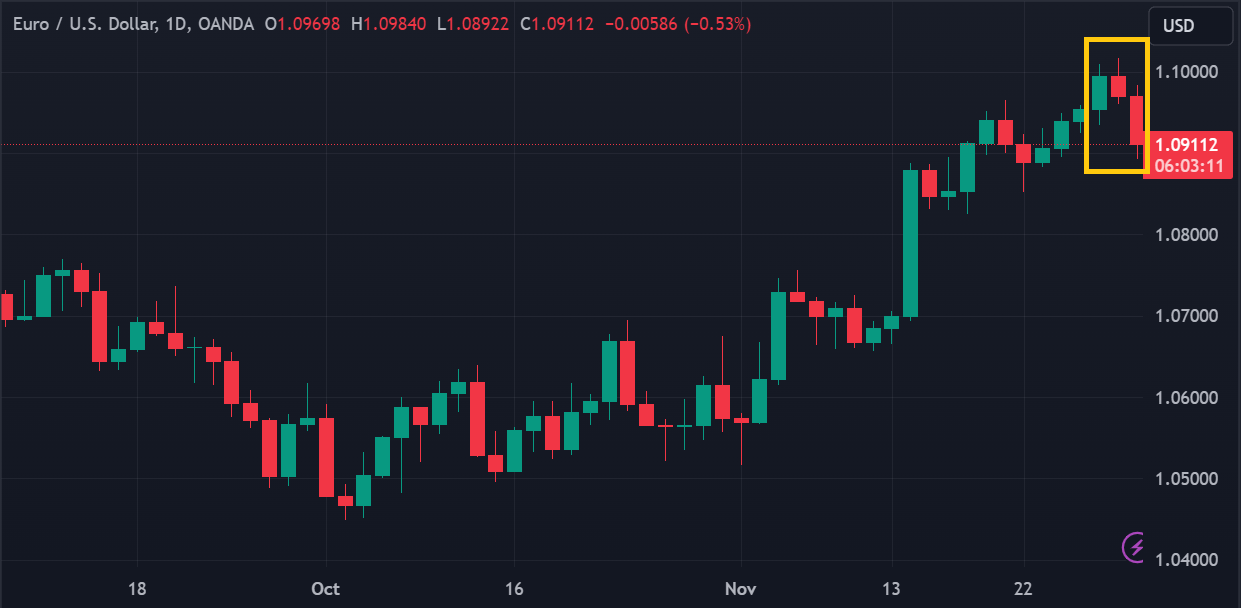The Eurozone's inflation rate slipped from 2.9 percent to 2.4 percent on an annual basis, causing the euro to weaken against all other majors.
The euro rate plunged in early trading in the New York session on Thursday (30/November). EUR/USD fell more than 0.5% to a range low of 1.0890s. EUR/GBP continued its bearish trend to the lowest level since October 12, while EUR/JPY is floating in the lowest range in a week.

The November 2023 Eurozone Consumer Price Index (CPI) preliminary report showed growth of -0.5% monthly, bringing the Eurozone inflation rate back to +2.4% on an annualized basis. The previous consensus only expected a decline in annual inflation from +2.9% to +2.7%.
Core inflation data fell more sharply, to -0.6%. Correspondingly, the pace of core inflation on an annualized basis plummeted from +4.2% to +3.6% (versus the consensus estimate of +3.9%).
European Central Bank (ECB) officials had previously argued that the decline in core inflation is slower than headline inflation, so it will take longer to reach the 2% inflation target on a sustainable basis. However, the data this time undermined this opinion.
The ECB projected an average inflation rate this year of 3.3% in its September report, but the latest data indicates that average inflation may have fallen to 2.65%. Consequently, market participants are now advancing the projected timing of the ECB's first rate cut and are eagerly dumping the euro.
"The euro took a dive on Thursday, retreating from three-and-a-half month highs against the US dollar, as weaker-than-expected CPI numbers out of the Eurozone pressured the single currency," says Raffi Boyadjian, Lead Investment Analyst at XM.com. "The data raised expectations that the ECB will cut interest rates soon, with the latest market forecasts suggesting that Europe may precede the Fed with the first-rate cut of this cycle."
Joe Tuckey, head of FX analysis at Argentex Group, said that the most recent central bank forecasts for average inflation of 3.2% in 2024 and 2.1% in 2025 may not be too high, and that the latest reading provides a "challenging landscape for any remaining ECB hawks."
"Markets are now beginning to price for an April cut, and the price action for EURUSD in the coming weeks will be partially driven by the rate cut timing from the ECB vis-a-vis that of the Federal Reserve," said Tuckey.
Compared to the Eurozone's sharp disinflationary trend, the decline in US inflation has been relatively slower. The US Core PCE Price Index released this evening still showed a growth of 0.2% in October 2023, while the annual pace only corrected from 3.7% to 3.5%.
The US Dollar Index (DXY) is currently hovering around 0.5% to 103.50s thanks to improved US GDP data and a slower decline in US inflation. Markets will be watching Fed Chair Jerome Powell's speech tomorrow to determine their next trading decision.

 Dedicated FREE FOREX VPS
Dedicated FREE FOREX VPS Free FOREX Virtual Private Server
Free FOREX Virtual Private Server MT4 Demo Contest, Get $500
MT4 Demo Contest, Get $500 Sign Up for an Account, Claim 60% Deposit Bonus
Sign Up for an Account, Claim 60% Deposit Bonus Free MT4/MT5 VPS 2024
Free MT4/MT5 VPS 2024 Send E-mail and Get Free Merchandise
Send E-mail and Get Free Merchandise $1K Refer a Friend Bonus for Pepperstone Pro clients
$1K Refer a Friend Bonus for Pepperstone Pro clients Maximize Your Earnings with 100% Deposit bonus
Maximize Your Earnings with 100% Deposit bonus Trade to Win, $5,000 Monthly Demo Contest
Trade to Win, $5,000 Monthly Demo Contest Claim 30% + 15% Deposit Bonus from LiteFinance
Claim 30% + 15% Deposit Bonus from LiteFinance






